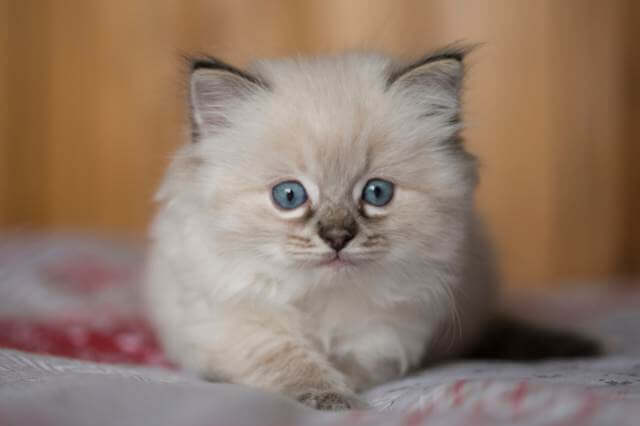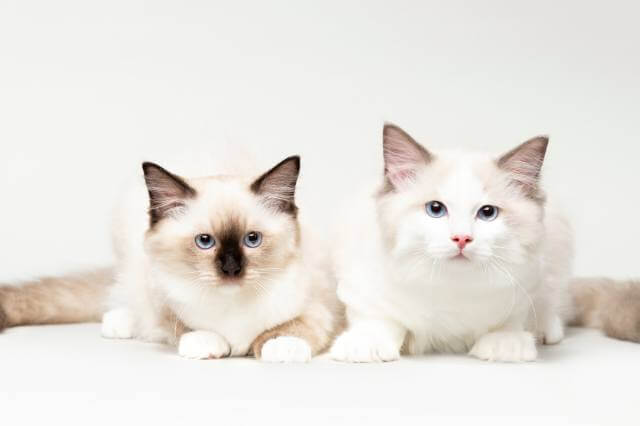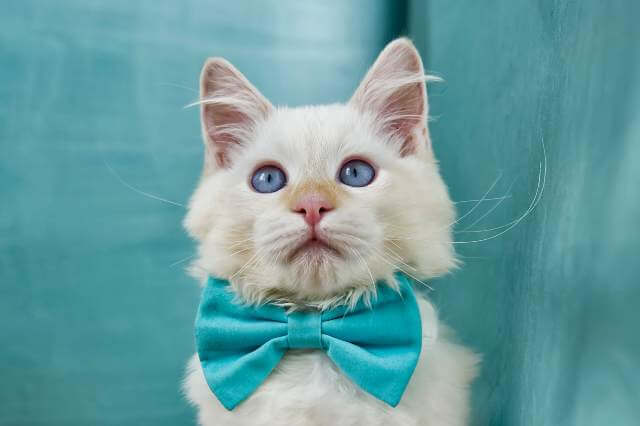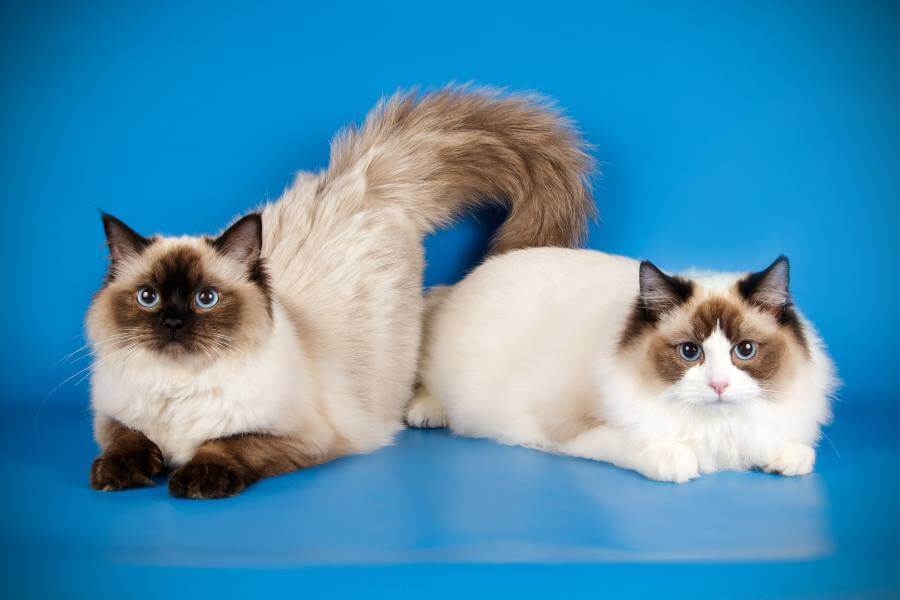Beautiful Ragdoll cats are distinguished by their colorpoint coats and crystal blue eyes.
One of the biggest domestic cat breeds in the cat fancy, ragdolls have a robust, muscular build and a long, silky-feeling coat.
The Ragdoll, created by Ann Baker in the 1960s, is well recognized for its easygoing nature, which makes it a wonderful family companion.
Because they have a propensity to flip when picked up, ragdolls got their name.
Table of Contents
How Were Ragdolls Created?
Typically, a breeder will start by selecting a special or desired trait for their new breed of cat.
Then they decide on a mating couple that can regularly generate kids with those traits.
Ann Baker, a lady, is said to have chosen the first Ragdoll breeding partners in 1963.
She picked two cats with characteristics that best represented the breed as we know it today: a big cat with a silky coat, vivid blue eyes, and traditional pointed markings.
But there are several stories about how this breed developed. None can be completely verified.
Ann Baker states in one tale that she came across a lovely male cat while borrowing animals for her Black Persian breeding operation.
This impressive cat resembled a male Birman. He was also the progeny of Josephine, a white angora cat.
Raggedy Ann Daddy Warbucks was the name of the guy that Ann would utilize to have litters with similar traits.
Blackie, his sibling, who helped broaden the gene pool while preserving the desirable traits, was also employed by her.
Other tales explore Josephine’s life a little more in-depth.
The Angora, according to the legend, was a rescue that Ann owned and was struck by a vehicle.
Josephine is thought to be pain-immune as a result of this tragedy, which accounts for her sloppy, carefree temperament.
The story of how Ragdolls got their name includes a reference to this.
When handled, they have a reputation for becoming limp-like rag dolls.
According to some versions, Raggedy Ann Daddy Warbucks was created by the intentional mating of Josephine and a Birman.
But depending on who is telling the history, these stories have somewhat different variants.
The only thing that is clear about the Ragdoll breed is that Josephine is the sole legal source of all acknowledged purebred Ragdolls.

Selecting a Ragdoll Feline
It is usually ideal to meet the Ragdoll in person, as well as the parents if that is a possibility.
Ragdolls of pure breeding can be of “breeder, show, or pet” quality.
A registered breeder should be the only one to whom a respectable breeder is sold.
A cat that is show quality satisfies the requirements and is a superb specimen of the breed.
A cat that is pet quality might be somewhat flawed, but these flaws are nearly usually aesthetic.
It could have a white spot where there shouldn’t be one, a kinked tail, or some tiny flaw.
Great cats that are made for pets are less expensive than show cats.
When ragdoll kittens are at least twelve weeks old, they should have received their first vaccinations, been wormed, and received parasite treatment.
Only then should they be weaned from their mother.
To avoid unintentional breeding, the majority of breeders now choose to have kittens spayed or neutered before they travel to their new home.
The Ragdoll’s Popularity
The Ragdoll breed has had its share of popularity spikes throughout the years.
After Lulu Rowley acquired a breeding pair of them in 1981, they first received tremendous praise when they were introduced to the world.
Soon after, Pat Brownsell, another breeder, received her breeding pair.
The Ragdoll established a strong reputation as the UK’s newest cat doll with the introduction of two breeders and two successful inaugural litters.
Even in the most recent years, this purebred has seen a growth in popularity.
There were 393 registered Ragdoll kittens in the early 1990s.
However, in 2003, this number skyrocketed to 1,376 and has since continued to rise.
The RFCI reports that there are currently more than 100 licensed breeders throughout the world.

Facts About Ragdoll Cats
They Are One of the Biggest Breeds of Cats
Male Ragdolls normally weigh between 15 and 20 pounds, and females between 10 and 15 pounds, according to the Cat Fanciers’ Association.
The Maine Coon, which can weigh up to 18 pounds, and the Norwegian Forest Cat, which may weigh up to 16 pounds, are two more huge felids that are somewhat larger than them.
Ragdoll Cats Resemble Dogs
Ever wished for a pet that would accompany you everywhere you go, play fetch with you, and sleep in your bed?
Think about getting a Ragdoll if you have a dog allergy.
Ragdoll Cats Are Reserved
Ragdolls are calm and kind. This characteristic led Realtor.com to formerly list them as one of the top cat breeds for apartments.
However, there is a drawback to this quality: If your Ragdoll is in discomfort or hurt, it might not meow, so be careful how you handle it.
Ragdolls Have Magnificent Coats and Blue Eyes
The Ragdoll is renowned for its sparkling blue eyes and color-pointed coat in addition to its fluffy fur and huge frame.
Ragdolls may be found in a wide range of colors, from seal and blue to red and cream.
It’s also typical to see variations like tortoiseshell and tabby markings.
There are many different patterns for ragdolls, such as colorpoint, bicolor, and mitted.
They are born light-colored, and as they age, their coats progressively deepen to take on their permanent colors.
Further Reading: Are Black Ragdoll Cats Rare?

This Breed Is Rather New
Ragdolls are attributed to breeder Ann Baker, who resided in California in the 1960s.
In her area, Baker discovered a domestic longhaired white female who she captured and mated with another longhaired cat.
The kittens that resulted served as the ancestors of the Ragdoll breed.
Baker finally created the huge, fluffy feline we know and love today by breeding for characteristics like a pleasant disposition and long, silky fur.
It’s possible that Baker crossed the first cat in the Ragdoll lineage with a Birman, Burmese, or Persian cat, or the animal had Siamese-like markings.
But since no one is fully sure which cat breeds Baker combined to create the Ragdoll, the breed’s traditional color-pointed coat’s ancestry is still somewhat a mystery.
Ragdolls Are Lap Cats
Ragdoll cats, unlike some other cats, like being carried and thrive on human company.
In reality, the breed is thought to have gotten its name because young kittens of the placid, outgoing cat would become floppy and limp when lifted up, much like rag dolls.
Final Thoughts
Despite their peculiar beginnings, Ragdolls have developed into a robust breed with lovely characteristics and eye-catching appearances.
Ann Baker did make an effort to establish a firm hold on the breed.
But we are delighted to see that Ragdolls are flourishing today as one of the most well-liked certified purebreds, due to committed breeders like the Daytons.
Further Reading:

